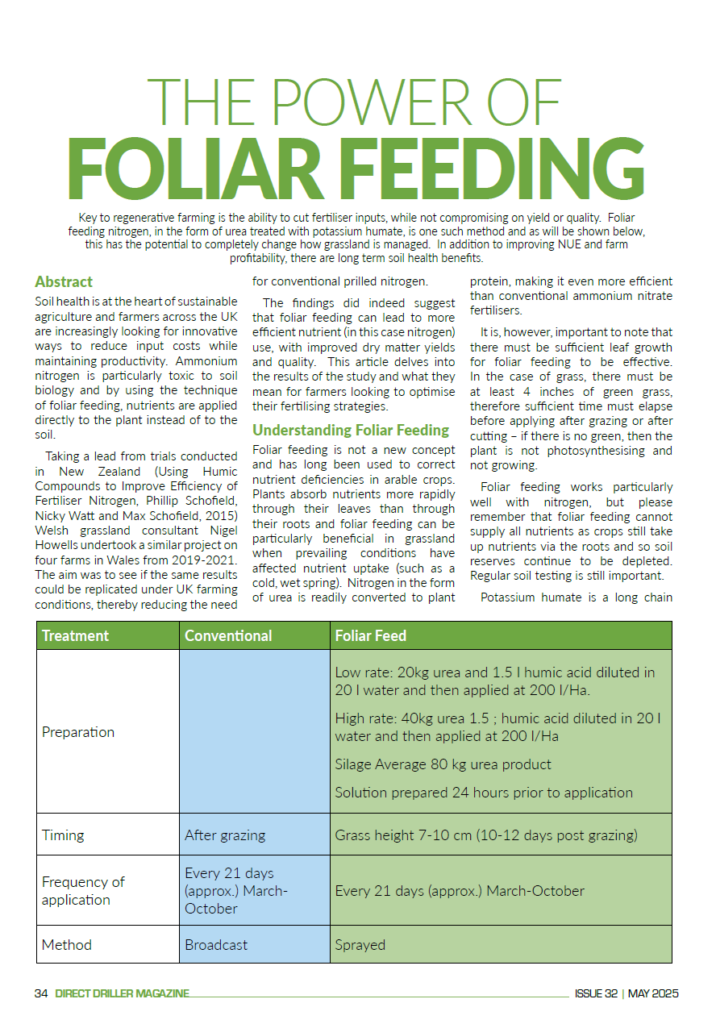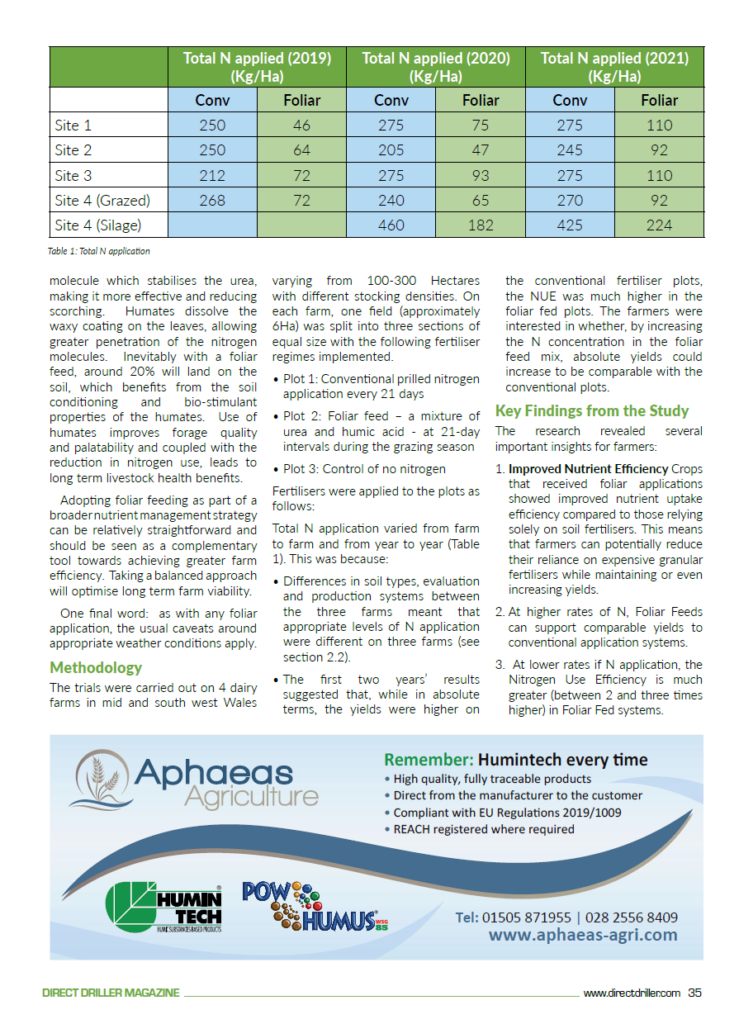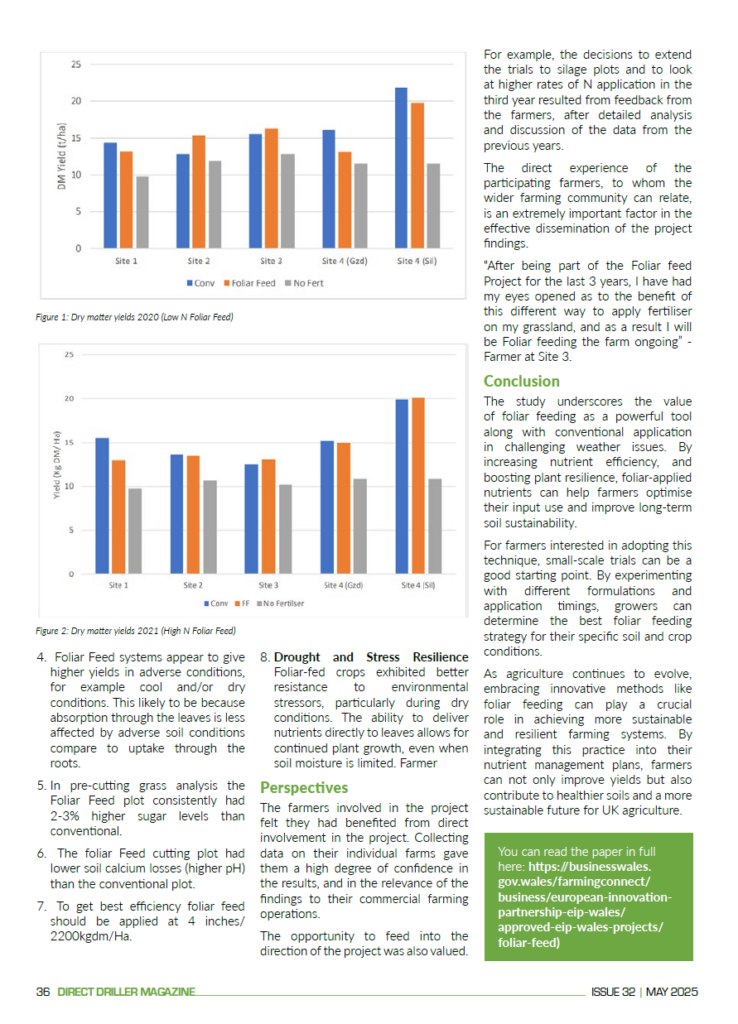Key to regenerative farming is the ability to cut fertiliser inputs, while not compromising on yield or quality. Foliar feeding nitrogen, in the form of urea treated with potassium humate, is one such method and as will be shown below, this has the potential to completely change how grassland is managed. In addition to improving NUE and farm profitability, there are long term soil health benefits.
Abstract
Soil health is at the heart of sustainable agriculture and farmers across the UK are increasingly looking for innovative ways to reduce input costs while maintaining productivity. Ammonium nitrogen is particularly toxic to soil biology and by using the technique of foliar feeding, nutrients are applied directly to the plant instead of to the soil.
Taking a lead from trials conducted in New Zealand (Using Humic Compounds to Improve Efficiency of Fertiliser Nitrogen, Phillip Schofield, Nicky Watt and Max Schofield, 2015) Welsh grassland consultant Nigel Howells undertook a similar project on four farms in Wales from 2019-2021. The aim was to see if the same results could be replicated under UK farming conditions, thereby reducing the need for conventional prilled nitrogen.
The findings did indeed suggest that foliar feeding can lead to more efficient nutrient (in this case nitrogen) use, with improved dry matter yields and quality. This article delves into the results of the study and what they mean for farmers looking to optimise their fertilising strategies.
Understanding Foliar Feeding
Foliar feeding is not a new concept and has long been used to correct nutrient deficiencies in arable crops. Plants absorb nutrients more rapidly through their leaves than through their roots and foliar feeding can be particularly beneficial in grassland when prevailing conditions have affected nutrient uptake (such as a cold, wet spring). Nitrogen in the form of urea is readily converted to plant protein, making it even more efficient than conventional ammonium nitrate fertilisers.
It is, however, important to note that there must be sufficient leaf growth for foliar feeding to be effective. In the case of grass, there must be at least 4 inches of green grass, therefore sufficient time must elapse before applying after grazing or after cutting – if there is no green, then the plant is not photosynthesising and not growing.
Foliar feeding works particularly well with nitrogen, but please remember that foliar feeding cannot supply all nutrients as crops still take up nutrients via the roots and so soil reserves continue to be depleted. Regular soil testing is still important.
Potassium humate is a long chain molecule which stabilises the urea, making it more effective and reducing scorching. Humates dissolve the waxy coating on the leaves, allowing greater penetration of the nitrogen molecules. Inevitably with a foliar feed, around 20% will land on the soil, which benefits from the soil conditioning and bio-stimulant properties of the humates. Use of humates improves forage quality and palatability and coupled with the reduction in nitrogen use, leads to long term livestock health benefits.
Adopting foliar feeding as part of a broader nutrient management strategy can be relatively straightforward and should be seen as a complementary tool towards achieving greater farm efficiency. Taking a balanced approach will optimise long term farm viability.
One final word: as with any foliar application, the usual caveats around appropriate weather conditions apply.
Methodology
The trials were carried out on 4 dairy farms in mid and south west Wales varying from 100-300 Hectares with different stocking densities. On each farm, one field (approximately 6Ha) was split into three sections of equal size with the following fertiliser regimes implemented.
• Plot 1: Conventional prilled nitrogen application every 21 days
• Plot 2: Foliar feed – a mixture of urea and humic acid – at 21-day intervals during the grazing season
• Plot 3: Control of no nitrogen
Fertilisers were applied to the plots as follows:

Total N application varied from farm to farm and from year to year (Table 1). This was because:
• Differences in soil types, evaluation and production systems between the three farms meant that appropriate levels of N application were different on three farms (see section 2.2).
• The first two years’ results suggested that, while in absolute terms, the yields were higher on the conventional fertiliser plots, the NUE was much higher in the foliar fed plots. The farmers were interested in whether, by increasing the N concentration in the foliar feed mix, absolute yields could increase to be comparable with the conventional plots.

Table 1: Total N application
Key Findings from the Study
The research revealed several important insights for farmers:
- Improved Nutrient Efficiency Crops that received foliar applications showed improved nutrient uptake efficiency compared to those relying solely on soil fertilisers. This means that farmers can potentially reduce their reliance on expensive granular fertilisers while maintaining or even increasing yields.
- At higher rates of N, Foliar Feeds can support comparable yields to conventional application systems.
- At lower rates if N application, the Nitrogen Use Efficiency is much greater (between 2 and three times higher) in Foliar Fed systems.
- Foliar Feed systems appear to give higher yields in adverse conditions, for example cool and/or dry conditions. This likely to be because absorption through the leaves is less affected by adverse soil conditions compare to uptake through the roots.
- In pre-cutting grass analysis the Foliar Feed plot consistently had 2-3% higher sugar levels than conventional.
- The foliar Feed cutting plot had lower soil calcium losses (higher pH) than the conventional plot.
- To get best efficiency foliar feed should be applied at 4 inches/ 2200kgdm/Ha.
- Drought and Stress Resilience Foliar-fed crops exhibited better resistance to environmental stressors, particularly during dry conditions. The ability to deliver nutrients directly to leaves allows for continued plant growth, even when soil moisture is limited.

Figure 1: Dry matter yields 2020 (Low N Foliar Feed)

Figure 2: Dry matter yields 2021 (High N Foliar Feed)
Farmer Perspectives
The farmers involved in the project felt they had benefited from direct involvement in the project. Collecting data on their individual farms gave them a high degree of confidence in the results, and in the relevance of the findings to their commercial farming operations.
The opportunity to feed into the direction of the project was also valued. For example, the decisions to extend the trials to silage plots and to look at higher rates of N application in the third year resulted from feedback from the farmers, after detailed analysis and discussion of the data from the previous years.
The direct experience of the participating farmers, to whom the wider farming community can relate, is an extremely important factor in the effective dissemination of the project findings.
“After being part of the Foliar feed Project for the last 3 years, I have had my eyes opened as to the benefit of this different way to apply fertiliser on my grassland, and as a result I will be Foliar feeding the farm ongoing” – Farmer at Site 3.
Conclusion
The study underscores the value of foliar feeding as a powerful tool along with conventional application in challenging weather issues. By increasing nutrient efficiency, and boosting plant resilience, foliar-applied nutrients can help farmers optimise their input use and improve long-term soil sustainability.
For farmers interested in adopting this technique, small-scale trials can be a good starting point. By experimenting with different formulations and application timings, growers can determine the best foliar feeding strategy for their specific soil and crop conditions.
As agriculture continues to evolve, embracing innovative methods like foliar feeding can play a crucial role in achieving more sustainable and resilient farming systems. By integrating this practice into their nutrient management plans, farmers can not only improve yields but also contribute to healthier soils and a more sustainable future for UK agriculture.
You can read the paper in full here: https://businesswales.gov.wales/farmingconnect/business/european-innovation-partnership-eip-wales/approved-eip-wales-projects/foliar-feed)



